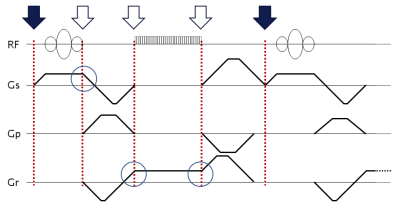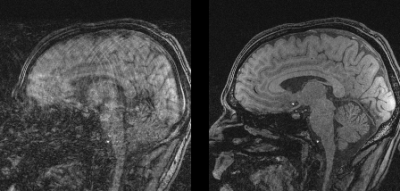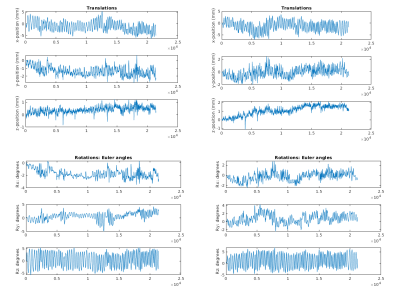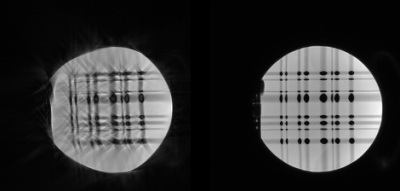1378
Real-time prospective motion correction of arbitrary MR pulse sequences with XPACE-Pulseq1High Field MR Center, Center for Medical Physics and Biomedical Engineering, Medical University of Vienna, Vienna, Austria
Synopsis
Although it is theoretically possible to prospectively correct for deteriorative effects of known rigid body motions in any arbitrary MRI pulse sequence, no practical open implementation was reported to date. In this work we extend Puseq, an open-source pulse sequence development environment with a prospective motion correction capability based on external tracking. Real-time motion information in six degrees of freedom is received from an optical motion tracking system by libXPACE (a generic library for eXternal Prospective Acquisition CorrEction). The framework is capable of both motion correction and motion artifact simulation of arbitrary pulse sequences saved in Pulseq format.
Introduction
A theoretical ability for correcting for motion artifacts arising from known 3D rigid body motion in six degrees of freedom has been suggested by multiple researchers [1-4]. This approach is based on the invariance of the Bloch equations in presence of motion upon an application of an appropriate set of transformations to the running sequence. However, a generic realization of such correction has been hampered up to now, presumably by the complexity of the sequence implementation in the vendor-specific environment. To the best of our knowledge, the closest non-commercial match towards this goal is the libXPACE, a library for the eXternal Prospective Acquisition CorrEction [5,6], implemented for numerous Siemens software platforms and distributed under the customer-to-customer partnership (C2P) program of Siemens Healthineers.In general, implementing novel MR pulse sequences often involves time-consuming programming in vendor-specific environments. The problem is further exacerbated if research sequences need to be implemented on several platforms simultaneously at different field strengths or in heterogeneous hardware environments. A recently presented Pulseq environment [7] is an open-source highly flexible pulse sequence programming framework, that allows for decoupling between the sequence design and the sequence execution steps. Pulse sequences in Pulseq are designed using a variety of open-source design tools [8-10] and saved thereafter in Pulseq format, which is an explicit description of the entire pulse sequence waveforms and timing. A so-called “Pulseq interpreter sequence” is then employed on the MR scanner to play out any arbitrary Pulseq files. The Pulseq interpreter sequence is freely available for all current Siemens platforms via the C2P program.
We hypothesize that the Pulseq format is well-suited for implementation of the generic prospective motion correction (PMC) of arbitrary MR pulse sequences.
Methods
Pulseq represents an MR pulse sequence as a gapless concatenation of non-overlapping time slices referred to as blocks. Each block contains no more than a single RF pulse, a single ADC event and a single gradient pulse per gradient axis. Arbitrary gradient shapes are supported naturally and transparently. Additionally a delay event can be specified. The duration of each block is defined by the longest event within the block. The gradient ramps for the trapezoid pulses are forced to be contained within the block boundaries. However, gradients with arbitrary shapes are not forced to 0 at the block boundaries, allowing for implementing time-efficient sequences. Fig. 1 shows an example of a gradient echo sequence with possible block boundary allocations.Pulseq interpreter allows for slice positioning using the integrated scanner’s UI. Rotations are achieved by applying corresponding rotation matrices to each of the blocks. Translation of the slice/slab/voxel positions is achieved by making all frequencies proportional to the applied gradients during the entire pulse sequence. These coefficients of proportionality for each gradient axis define the effective null-points of the phase dispersion induced by the corresponding gradient. This generic approach is compatible with any arbitrary RF excitation modules, readout trajectories or reordering schemes. Siemens platforms provide a built-in support for such functionality (largely unused by the product sequences), on other platforms it could be possible to achieve the same effect by an appropriate bookkeeping.
libXPACE is a generic library for communication with external tracking devices. Additionally it can simulate motion by using dummy sources, such as random generators or previously recorded motion data. For traditional pulse sequences developed in the vendor environment the pulse sequence designer needs to decide, when it is appropriate to apply slice position updates within the pulse sequence (typically in the beginning of TR prior to the excitation RF pulse). Corresponding update directives need to be applied prior to the execution of the respective portion of the sequence timing. Although this is easily achieved in some sequences, the corresponding optimal locations may also be buried in depths of “building-block” libraries, oftentimes with restricted source code access.
Although it was technically feasible for all Pulseq blocks (open errors in Fig 1), this proof-of-concept implementation XPACE-Pulseq only applied updates prior to the blocks containing RF pulses. Correction of the blocks which boundaries are crossed by non-zero gradients has also been disabled and will be investigated in the future. 3D gradient echo (TE/TR=6/15ms, FA=15°) with the isotropic spatial resolution of 1mm was programmed in Pulseq [8]. For in vivo experiments optical tracking system (Metria Innovation) was used to track a marker attached to a custom mouth piece. Phantom imaging was done in a 3D printed phantom containing elliptical bars with randomized thickness and spacing.
Results
Figure 2 shows in vivo motion correction results in presence of head rotations without and with PMC with the corresponding motion shown in Figure 3. Figure 4 shows phantom images acquired with the same pulse sequence in a stationary phantom without any correction or using the motion data from Figures 2/3(left) to simulate motion artifacts [9]. Figure 5 demonstrates the possibility of investigating motion sensitivity of other pulse sequences using the presented XPACE-Pulseq framework.Conclusions
The combined XPACE-Pulseq framework demonstrates the feasibility of prospective motion correction of arbitrary pulse sequences. The approach is expected to be useful for investigating motion sensitivity of novel pulse sequences.Acknowledgements
No acknowledgement found.References
1. Shechter G and McVeigh E R 2003 MR motion correction of 3D affine deformations. Proc. 11th Scientific Meeting of ISMRM p 1054
2. Batchelor PG et al. 2005 Matrix description of general motion correction applied to multishot images. Magn Reson Med 54 1273-80
3. Nehrke K and Börnert P 2005 Prospective correction of affine motion for arbitrary MR sequences on a clinical scanner. Magn Reson Med. 54 1130-8
4. Maclaren J et al. 2013 Prospective motion correction in brain imaging: a review Magn Reson Med 69 621-36. doi: 10.1002/mrm.24314.
5. Zaitsev M et al. 2006 Magnetic resonance imaging of freely moving objects: prospective real-time motion correction using an external optical motion tracking system. Neuroimage 31:1038-50. doi: 10.1016/j.neuroimage.2006.01.039.2006
6. Maclaren J et al. 2012 Measurement and Correction of Microscopic Head Motion during Magnetic Resonance Imaging of the Brain. PLoS ONE 7(11): e48088. doi: 10.1371/journal.pone.0048088
7. Layton KJ et al. 2016 Pulseq: A rapid and hardware‐independent pulse sequence prototyping framework. Magn Reson Med. http://dx.doi.org/10.1002/mrm.26235
8. http://pulseq.github.io/
9. http://github.com/imr-framework/pypulseq
10. http://www.jemris.org/
11. Herbst M et al. 2014 Reproduction of motion artifacts for performance analysis of prospective motion correction in MRI. Magn Reson Med. 71:182-90. doi: 10.1002/mrm.24645
Figures




